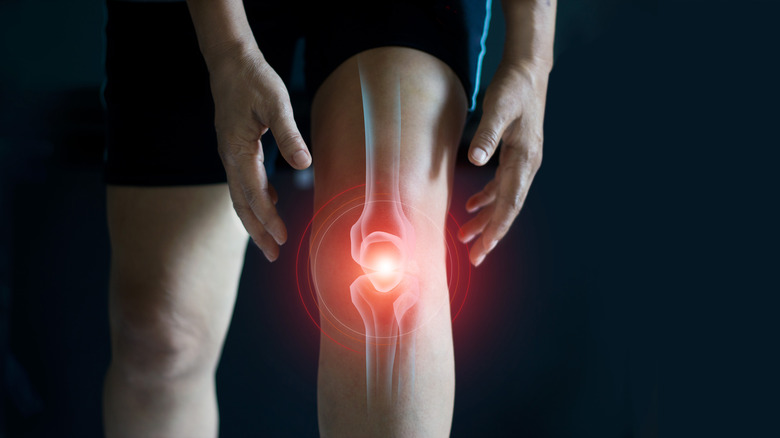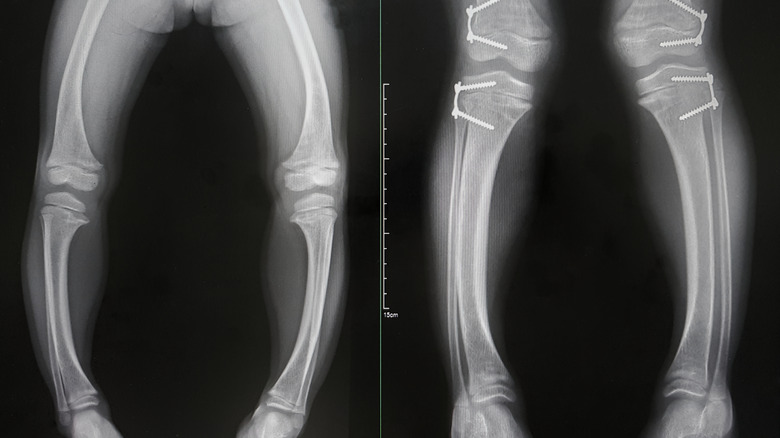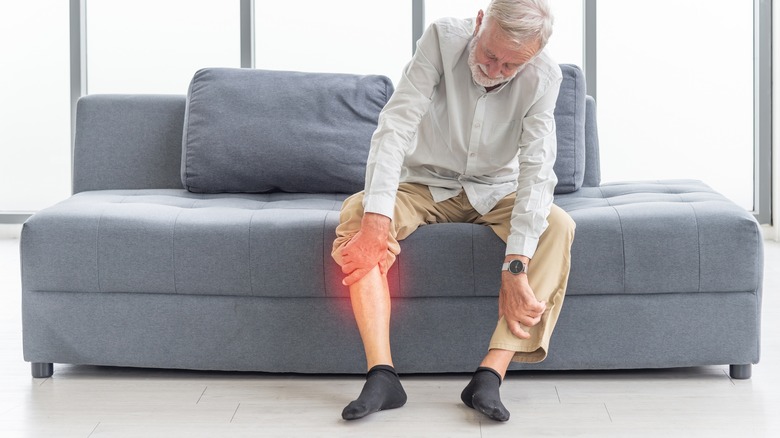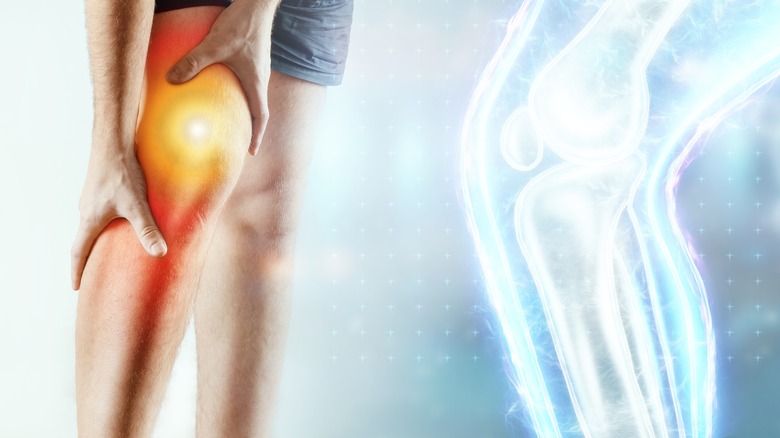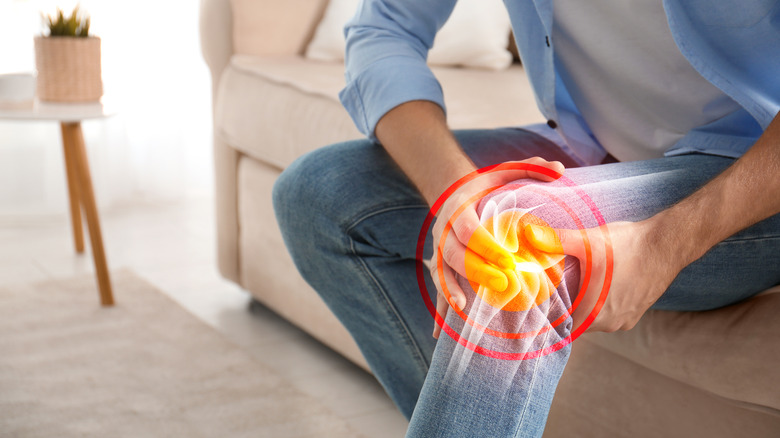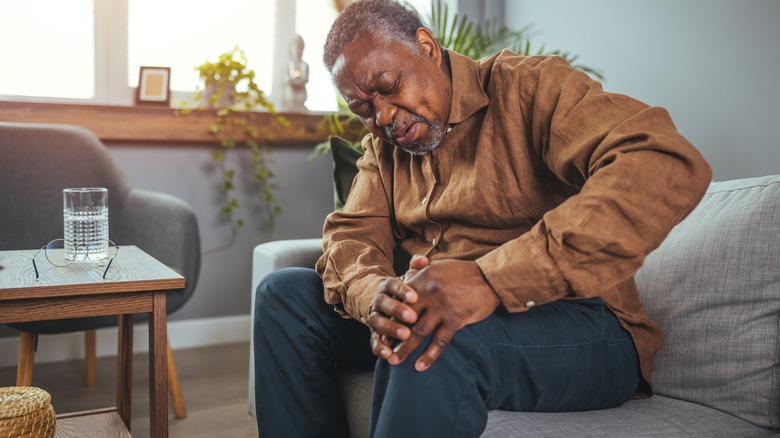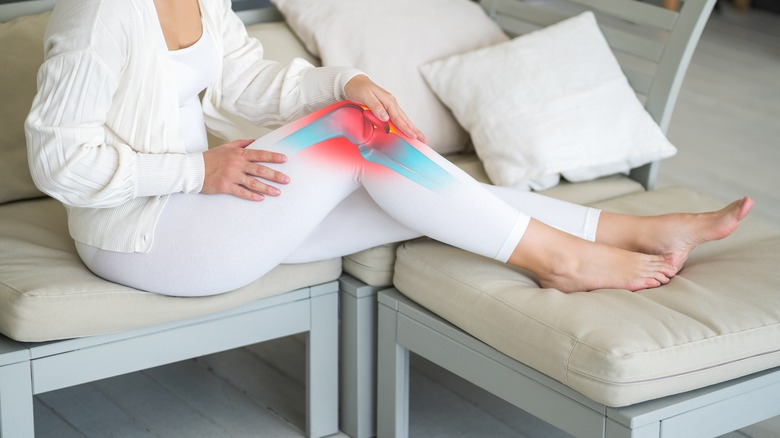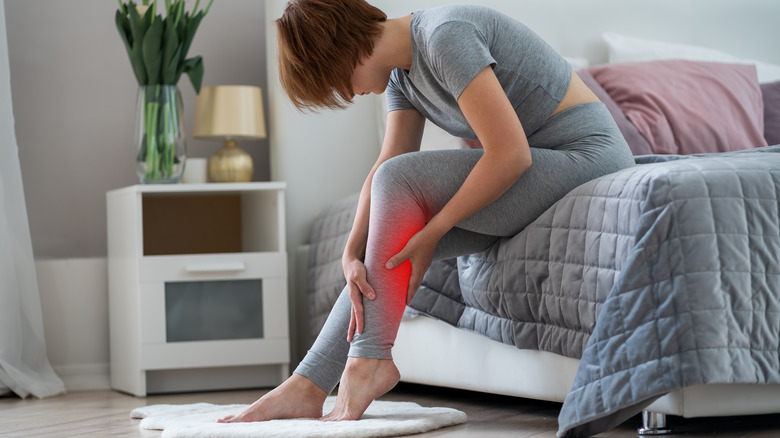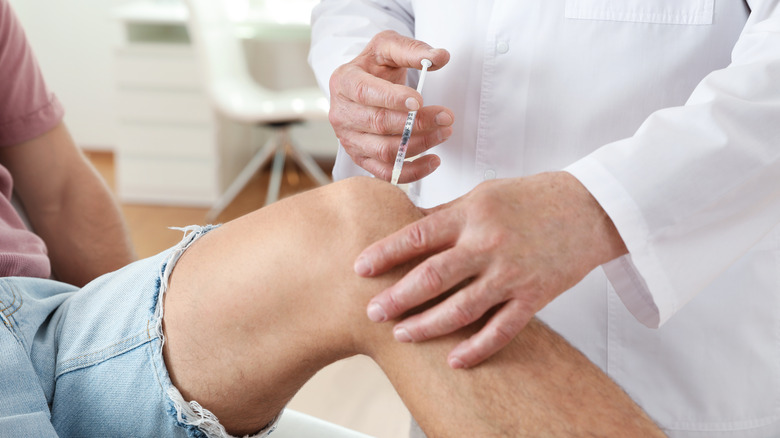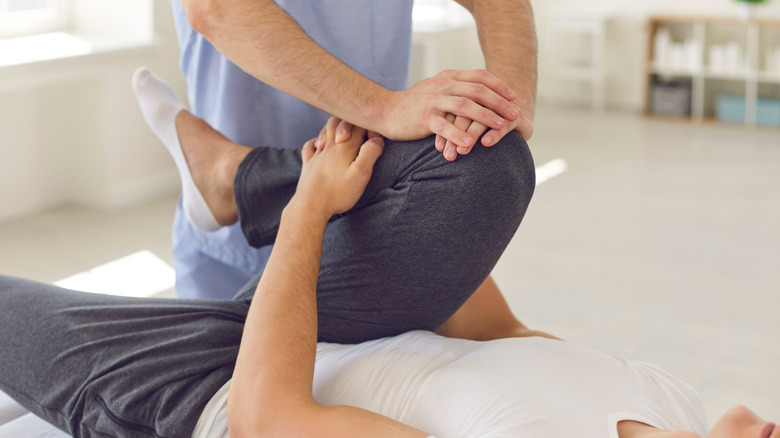Warning Signs From Your Knees You Shouldn't Ignore
The medical professionals at Classic Rehabilitation, Inc. report that knee pain is the second most prevalent origin of chronic pain, with more than 30% of Americans having pain in their knees at some point in their lifetime. Doctors at the American Academy of Orthopaedic Surgeons (AAOS) most frequently treat sprains, ligament tears, fractures, and dislocations.
Your knees are made up of several structures, including bones and a kneecap, covered and protected by two types of cartilage and connected to the rest of your body by four different ligaments and two tendons. "Three bones meet to form your knee joint: the femur (thighbone), the tibia (shinbone), and the patella (kneecap). The patella sits in front of the joint to provide some protection" (per the AAOS). While the bones make the joint, the ligaments keep your knee stable and control your knee's side-to-side and up-and-down motion. The tendons connect your muscles to your bones.
Some common causes of knee pain include aging, wear and tear, stress, injuries, and strains (per Johns Hopkins University). Additionally, being overweight also increases your risk of developing knee pain. Regardless of the cause, it often starts suddenly and worsens over time (via MedlinePlus).
Deformity
Normal knees are shaped to distribute weight and work evenly (via Dr. Elviz Gasimov). However, various factors can lead to abnormalities, including developmental and congenital issues, arthritis, and metabolic bone disease. In addition, trauma, fracture, and infection can also cause contortion to your knees (per Physiopedia).
Dr. Elviz Gasimov reports that two main types of malformations affect the knees, valgus and varus. You are said to have a valgus deformity if your knees turn inward. As a result, your legs look x-shaped when you stand, and the load rests on the sides of your knees. Varus knee deformities occur when your knees curve outward, creating the shape of an "O" when you stand. As a result, your knees never touch, and the load is placed on the inside of your knee.
According to the Hospital for Special Surgery, most children are born with their knees in the varus or bow-legged position. Then, as they learn to walk, their legs become more valgus or knock-kneed. Their legs should straighten out by the age 7 or 8.
The doctors at Hospital for Special Surgery recommend seeking further examination and correction by a medical professional if you notice that your or your child's leg angles worsen with time or are only abnormal on one side.
Limping
Normal walking is a repetitive and balanced process (via Antalgic Gait in Adults). Austrian neurologists quoted in Wien Klin Wochenschr explain, "To start walking, one leg is raised and directed forward by flexing the hips and knee. Activation of the supporting contralateral leg and trunk muscles moves the body's center of gravity over the weight-bearing leg and forward. The heel of the swinging leg is then placed on the ground. The body weight is gradually shifted to the sole and then onwards to the toes. During mid-stance, the opposite leg is lifted and moves forward until the heel strikes the ground. Meanwhile, the body is held upright, the shoulders and pelvis remain relatively level, and each arm swings in the direction opposite to that of its ipsilateral leg."
Injuries, infections, and tumors cause foot, knee, or hip pain that interrupts the walking process and causes you to avoid putting pressure on the body part that hurts and results in a limp (via Healthline).
Dr. Douglas Dirschl, Lowell T. Coggeshall professor and chairman of the Department of Orthopaedic Surgery and Rehabilitation Medicine at the University of Chicago, estimates that close to one-fifth of the population has a noticeable antalgic gait or limp. This includes Usain Bolt, who "has a slight leg-length discrepancy."
Depending on the cause of the pain behind your limp, treatment includes medications, mobility devices, physical therapy, and surgery (per Healthline).
Inability to Hold Weight
Medical professionals at Physiopedia explain that when you stand, your legs should be able to carry all of your body weight. However, the inability to bear weight is common after minor injuries. Therefore, if you don't quickly recover, seek medical attention as doing so could make the injury worse and prolong your recovery time (per iWALKFree).
"Inability to bear weight after a knee injury could be caused by a fracture, bone contusion, cartilage injury or ligament tear," Dr. Taylor Brown, orthopedic surgeon at Houston Methodist in Texas, explains to Aaptiv. "If it's immensely painful to stand or put any weight on your injured knee, there's definitely something serious going on."
The amount of time you remain unable to put weight on your knees depends on the type and severity of your injury. However, according to an American Orthopedic Foot and Ankle Surgeons survey referenced by iWALKFree, the average time is five to eight weeks. Dr. Brown adds that during this time your doctor will have you use crutches or a knee scooter to enable you to get around without putting weight on the injured knee.
Regardless of how much better you feel during recovery, it's essential that you follow your doctor's orders as to how long to keep weight off your knee to avoid further injury and increase your time off your leg (per iWALKFree).
Wobbling
The British Journal of Sports Medicine printed a study that shows people unable to stand on one leg for 10 seconds had a 50% greater risk of dying within a decade. In fact, according to CNN, the study found that those unable to complete the balance test had an 84% higher risk of death from any cause, regardless of age, BMI, and preexisting conditions or health risks.
However, National Spine & Pain Centers reports that wobbly legs affect more than 10% of adults due to not properly warming up or cooling down. You may also need to do more exercises to strengthen your leg muscles. Wobbling knees can also result from tendonitis, sprains, and broken bones. Additionally, the CDC reports that nearly 33 million people in the United States have osteoarthritis caused by aging and overuse wearing down the cartilage in your knees.
Osteoarthritis is treated with bi-annual corticosteroid injections. Additionally, aquatic therapy and cross-training help improve your muscle balance (per Barr Center for Innovative Pain & Regenerative Therapies).
Shaky or weak legs and knees could also indicate deep vein thrombosis or blood clots. If left untreated, clots are extremely dangerous as they could break off into the bloodstream and travel to an artery in the lungs, blocking blood flow. Leg weakness, accompanied by weakness in other parts of your body, can also indicate a stroke and a blood vessel in your brain has burst. (via National Spine & Pain Centers).
Loss of feeling
Paresthesia is the technical term for the loss of feeling that can occur throughout your body resulting in a pins-and-needles sensation that many refer to as falling asleep (via GoodRx). According to MVMT Physio & Chiro, the most common cause is nerve compression resulting from repetitive motions, genetics, or previous injuries.
Additionally, Healthline reports that sitting for a long time with your legs crossed or clothes that are too tight can cut off your circulation or put pressure on the nerves in your knees, resulting in numbness. The same is true for the swelling and inflammation related to knee injuries and arthritis.
Other causes of numb knees include kneecap dislocation, bursitis, and tendonitis. Accidents and sudden twisting can cause your kneecap to move out of place, causing, among other things, inflammation and numbness. In addition, if the fluid-filled sac that cushions the joint in your knee gets injured, it can cause a loss of feeling. The same is true for the soft tissue, known as tendons, that connect the muscles to bones in your knee (per azcentral).
Medical professionals at Winchester Hospital also list damage to the peroneal nerve outside your lower knee as a cause of numbness. In addition, those at MVMT Physio & Chiro report that diabetes, rheumatoid arthritis, and hypothyroidism can escalate the problem.
Treatment for the causes of loss of feeling in your knee range from moving your legs into a different position to needing medical care — it usually starts with rest, ice, heat, and elevation (per Healthline).
Excruciating pain
Studies referenced by Healthline show that severe pain that limits daily activities occurs mainly in the center of the joint, the kneecap, or both. Excruciating pain results from several causes, including tears to the ligaments that link your thigh bone to the bones in your lower legs and keep your knee stable. Tears to the cartilage at the end of the bones can also cause unbearable pain, as can several different forms of arthritis.
Less common causes of intense pain include osteonecrosis, a condition in which your bone tissue dies from an inadequate blood supply and tumors (per Arthritis-health).
The medical professionals at Dr. Larry L. Likover's office warn that whether it develops over time or comes on suddenly, severe pain in your knees should not be left untreated as it could cause further injury and complications. While initial treatment depends on the cause, knee replacement surgery is one of the most common ways to relieve unrelenting excruciating pain. iData Research reports that nearly 1 million people underwent knee replacement surgery in 2017. That number is expected to increase to more than three million by 2030 (per The Center).
Chronic pain
Medical professionals at Lone Star Neurology define chronic knee pain as developing over time and lasting for over three months. Some describe it as throbbing, while others state it occurs with movement or increases during exercise. Either way, The Washington Post reports that 25% of American adults suffer from chronic pain.
Osteoarthritis is the most common cause of chronic knee pain (via The Washington Post). Osteoarthritis affects nearly 30 million people in the United States and results from worn cartilage. Doctors with University of Maryland Baltimore Washington Medical Center explain that cartilage is a thin cover (or cushion) designed to protect your joint and make it slippery. Chronic pain results as your cartilage deteriorates from injury, playing a sport, or age. The Washington Post explains that cartilage doesn't have pain receptors, and only after it's depleted do problems and pain arise.
MedicalNewsToday lists additional causes of chronic knee pain as injuries, infections, cysts, tumors, obesity, gout, and not stretching before exercise.
Reduced range of motion
Physio.co.uk defines the reduced range of motion in your knee as diminished action due to stiffness or pain that limits the joint's ability to maneuver as usual. Range of motion can be reduced both actively and passively. Active range of motion refers to movements you do through muscle control and is limited by pain, weakness, or something in the way. Passive range of motion requires someone else to take your knee through the actions and is often done during physical therapy. Passive range of motion gets restricted when the joint is swollen, deformed, or contains a foreign object.
Additionally, for the best use of your legs, the range of motion in both knees should be the same (per SPORT MEDICINE).
Medical professionals at Icahn School of Medicine at Mount Sinai point to dislocation, fractures, infections, and tears within the joint as causes of reduced range of motion. Additionally, osteoarthritis, rheumatoid arthritis, and a chronic form of arthritis known as ankylosing spondylitis can also lessen your ability to move your knees.
Unless your problem is due to a meniscus tear, doctors usually treat a reduced range of motion in your knees using a directed rehabilitation program. Tears to the meniscus require arthroscopic surgery (via SPORT MEDICINE).
Clicking or popping
Nearly 99% of the population reports their knees make noise at one point or another. Also referred to as crepitus, it often isn't a cause for concern. The clicking you hear results from bubbles popping in the fluid in your knees, normal kneecap movement, or tendons and ligaments coming into contact with your joint (per QV Physiotherapy).
However, if pain, swelling, or other symptoms accompany the popping, see a doctor. These noises could result from a torn meniscus, injury to your cartilage, a tendon or ligament tear, or patellar femoral syndrome, which results from the inability of your knee to move up and down properly. The clicking you hear is the joint catching as you bend or straighten it (per MedicalNewsToday).
Additionally, a study referenced by the U.S. Department of Veterans Affairs showed that more than 10% of those who said their knees made noise had signs of arthritis within a year. Therefore, Dr. Grace Lo, rheumatologist and researcher with Baylor College of Medicine and the VA Center for Innovations in Quality, Effectiveness, and Safety, in Houston, recommends people with noisy knees "get regular X-rays to check for evidence of osteoarthritis." Then, if something is seen on the x-ray, "it might be helpful to follow some common-sense precautions to decrease the risk of developing frequent knee symptoms." These include losing weight and avoiding contact sports.
Treatment for noisy knees includes walking and swimming, over-the-counter medications, steroid injections, alternating between heat and ice, and physical therapy (via Healthline).
Fever
Arthritis-health mentions three medical issues in which severe knee pain results, including an infection from bacteria or virus getting into your knee or an auto-immune reaction to an infection somewhere in your body; septic knee arthritis, reactive arthritis, and septic knee bursitis.
Septic arthritis occurs when the joint in your knee is attacked by a microorganism, usually bacteria. This type of infection affects around 20,000 people in the United States annually (per Medscape). And, "Septic arthritis is primarily a disease of children, with more than half of cases occurring before age 20." While septic arthritis can affect any joint in the body, nearly 50% of the time (in adult cases), the knee is involved (via ScienceDirect).
Reactive arthritis results from an irregular immune system response to an infection elsewhere in the body. You can get over the original sickness months before reactive arthritis affects your knees and other joints (per Arthritis-health). This rare illness affects 0.6 to 27 per 100,000 (via Reactive Arthritis).
According to the Archives of Orthopaedic and Trauma Surgery, bursitis occurs in 10 out of 100,000 people, with one-third of cases diagnosed as septic. Septic knee bursitis results from an infection in the fluid-filled sacs that protect your soft tissue from your bones. This illness most often affects plumbers, carpenters, roofers, athletes, those with gout, and those with inflammatory arthritis (per StatPearls).
Treatment for infected joints include antibiotics and over-the-counter pain medication. Fluid drainage may also occur (per Healthline).
Swelling
If you put your knees together and one looks significantly bigger than the other, it may be swollen (via Orthopedic & Sport Medicine Center of Oregon). According to medical experts at Harvard Health Publishing, puffiness results from increased fluid in or near the knee joint, blood accumulating in your knee, or bone expansion. Additionally, MedicalNewsToday defines knee swelling based on where it occurs, and inflammation in the joint is effusion. Edema happens in the tissue around your knee. Finally, hemarthrosis develops due to blood accumulation in your knee joint.
Four common causes of knee swelling are bursitis, arthritis, injuries, and infections (per MedicalNewsToday). Bursitis occurs when the fluid-filled sacs that reduce knee friction go into overproduction, usually due to overuse, trauma, or illness, according to the American Academy of Orthopaedic Surgeons (AAOS). The Arthritis Foundation lists osteoarthritis, rheumatoid arthritis, gout, and reactive and infective arthritis as causes of knee swelling, along with injuries that cause swelling sprains, tendonitis, and torn cartilage. Lupus and Lyme disease are two infections that result in swelling, explains MedicalNewsToday.
More than a quarter of those that participated in a study done by Occupational & Environmental Medicine experienced knee swelling, with 15% stating it occurred within a year prior and 10% indicating their knees were swollen in the past month.
Treating swollen knees often starts with RICE (Rest, Ice, Compression, and Elevation) and over-the-counter pain relievers. Your doctor may also recommend physical therapy and weight loss. If swelling persists, you may need a lubrication injection or have the excess fluid removed (per the Cleveland Clinic).
Calf pain
Because your knees and calves have to work together when you move, their pain can also intermingle, and pain in both results from strained muscles, tendinitis, and sciatica (via Panther Physical Therapy).
According to the NHS, a common cause of calf pain related to your knee is swelling from a Baker's or popliteal cyst resulting from an injury, gout, or arthritis. The American Academy Of Orthopaedic Surgeons (AAOS) describes this type of cyst as a lump behind your knee. A similar condition is popliteal artery entrapment syndrome (PAES) which arises due to an enlarged calf muscle trapping the main artery behind your knee, restricting blood flow and causing pain (per the Mayo Clinic).
Panther Physical Therapy also mentions popliteal tendinitis in relation to knee and calf pain because your popliteal tendon links your popliteal muscle (found in your knee), to your upper calf and thighbone. Repetitive motion can irritate the tendon, causing pain.
Like other related pain, calf pain is most often treated at home with RICE (Rest, Ice, Compression, and Elevation) and over-the-counter pain relieves. In addition, your doctor can drain especially painful Baker's cysts, but due to their makeup, removal is difficult (per NHS).
Types of knee doctors
Medical professionals at the Hospital for Special Surgery (HSS) recommend you see either an orthopedic surgeon or a physiatrist to address your knee pain. Orthopedic surgeons specialize in issues associated with the musculoskeletal system, including your bones, joints, muscles, and tissues. At the same time, sports medicine doctors treat and prevent injuries non-surgically (per the Center for Orthopaedic Surgery and Sports Medicine).
Therefore, if your knee pain results from a car or on-the-job accident, or you know the problem occurred during physical activity, you should see an orthopedic surgeon to treat the trauma. However, if you are unsure how your knee pain arose and didn't have an actual injury, see a physiatrist (per HSS).
A doctor specializing in pain management can also help address your knee issues. Pain Treatment Specialists describe three types of pain doctors, palliative care specialists, interventional pain doctors, and chronic pain specialists. Palliative care specialists treat psychological and emotional disease-related pain. Additionally, interventional pain doctors use minimally invasive and non-surgical procedures to treat the root cause of your pain and provide long-term relief. Finally, chronic pain specialists prescribe painkillers and narcotics to relieve the pain temporarily and should be your last resort, as the medication could be addicting.
Preventing knee problems
According to Dr. Jervis Yau, orthopedic surgeon with the Cottage Center for Orthopedics, "Although we cannot stop the aging process, there are things that may help decrease the risk of developing painful osteoarthritis. A little prevention now can save considerable pain later."
Medical professionals with the National Institute of Arthritis and Musculoskeletal and Skin Diseases (NIAMS) recommend speaking with your doctor before beginning any exercise routine and gradually adding the activities to your life. Your workout should include range-of-motion and stretching, strengthening exercises with weights, as well as balance and agility drills, and low-impact movements.
In addition, the doctors at OrthoNY suggest maintaining a healthy weight and always stretching and warming up before exercising — along with cooling down and allowing for recovery afterward.
The shoes you wear also affect your knees. Wearing supportive and comfortable shoes, especially while exercising, keeps pressure off the joint in your knee and enables proper leg alignment and balance. "When high heels lift your heel up, your weight bearing line tips forward so your quadriceps have to work harder to hold your knee straight, which then leads to knee pain," says Dr. Charles Bush-Joseph, sports medicine surgeon at Rush. "Whereas, if your heel is closer to the floor in low pumps or flats, your thigh muscles don't have to work as hard to maintain stability, which is easier on the knees."

